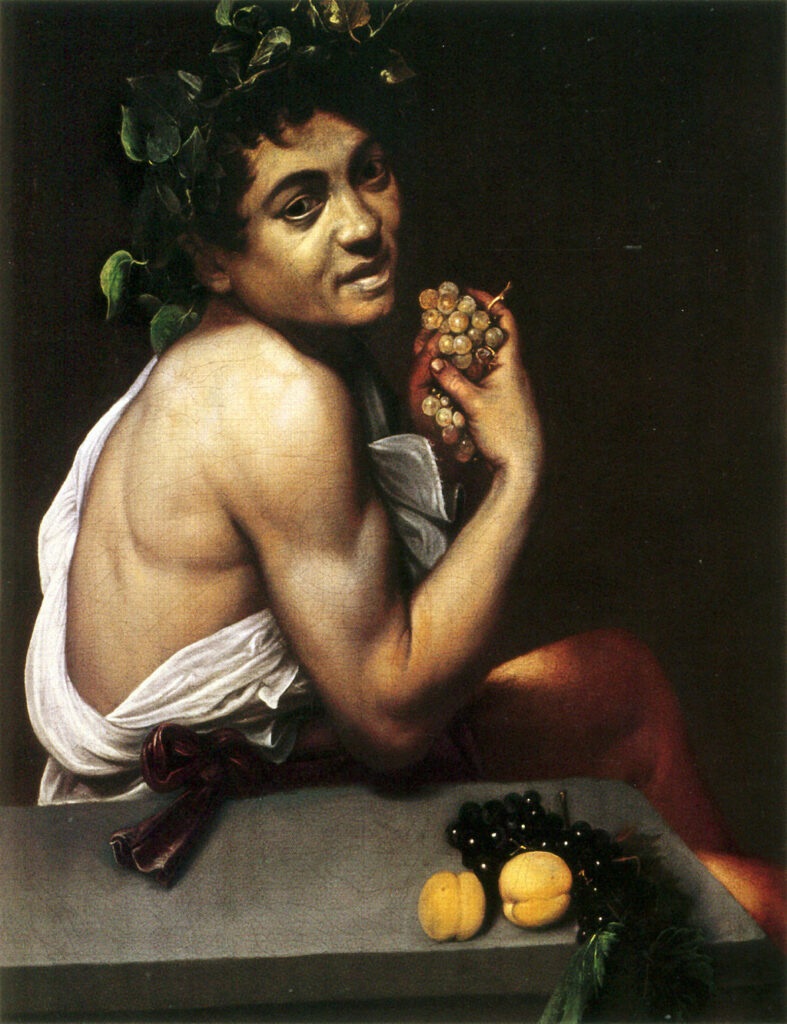
Caravaggio, Self-portrait as the Sick Bacchus. Public domain, via Wikimedia Commons.
Pasolini’s pen was preternatural in its output. Collected by the publishing house Mondadori in their prestigious Meridiani series, his complete works in the original Italian (excluding private documents such as diaries, and his immense, largely unpublished, epistolary exchanges in various languages) fill ten densely printed volumes. The twenty thousand or so pages of this gargantuan oeuvre suggest that, in the course of his short adult life, Pasolini must have written thousands of words every day, without fail.
Allusions to painting—and to the visual arts more broadly—appear across the full range of Pasolini’s writings, from journalistic essays to poetry and work for theater and film. The intended destination of the textual fragment below, which remained unpublished during Pasolini’s lifetime, remains uncertain. We know, however, that it was most likely penned in 1974. The “characterological” novelty of Caravaggio’s subjects, to which Pasolini alludes in passing, underscores some of the parallels between the two artists’ bodies of work: an eye for the unlikely sacredness of the coarse and squalid; a penchant for boorishness to the point of blasphemy; an attraction to louts and scoundrels of a certain type—the “rough trade,” of homosexual parlance.It is striking, for instance, that some of the nonprofessional actors that Pasolini found in the outskirts of Rome and placed in front of his camera bear an uncanny resemblance to the “new kinds of people” that Caravaggio “placed in front of his studio’s easel,” to quote from the essay presented here. Take Ettore Garofolo, who for a moment in Mamma Roma looks like a tableau vivant of Caravaggio’s Bacchus as a young waiter. Even the illness that ultimately kills that subproletarian character—so often read as a metaphor of the effects of late capitalism on Italy’s post-Fascist society—is born out of an art historical intuition that is articulated in this fragment on Caravaggio’s use of light.
But it was equally an exquisite formal sense—a search after “new forms of realism”—that drew Pasolini to Caravaggio’s work, particularly the peculiar accord struck in his paintings between naturalism and stylization. Pasolini professed to “hate naturalism” and, with some exceptions, avoided the effects of Tenebrism in his cinema. It is, instead, the very artificiality of Caravaggio’s light—a light that belongs “to painting, not to reality”—which earns his admiration.
The Roberto Longhi mentioned below is Pasolini’s former teacher, an art historian at the forefront of Caravaggio studies. It was Longhi who resurrected the painter from a certain obscurity in the twenties, arguing for the consequence of his work to a wider European tradition from Rembrandt and Ribera to Courbet and Manet.
—Alessandro Giammei and Ara H. Merjian
Anything I could ever know about Caravaggio derives from what Roberto Longhi had to say about him. Yes, Caravaggio was a great inventor, and thus a great realist. But what did Caravaggio invent? In answering this rhetorical question, I cannot help but stick to Longhi’s example. First, Caravaggio invented a new world that, to invoke the language of cinematography, one might call profilmic. By this I mean everything that appears in front of the camera. Caravaggio invented an entire world to place in front of his studio’s easel: new kinds of people (in both a social and characterological sense), new kinds of objects, and new kinds of landscapes. Second: Caravaggio invented a new kind of light. He replaced the universal, platonic light of the Renaissance with a quotidian and dramatic one. Caravaggio invented both this new kind of light and new kinds of people and things because he had seen them in reality. He realized that there were individuals around him who had never appeared in the great altarpieces and frescoes, individuals who had been marginalized by the cultural ideology of the previous two centuries. And there were hours of the day—transient, yet unequivocal in their lighting—which had never been reproduced, and which were pushed so far from habit and use that they had become scandalous, and therefore repressed. So repressed, in fact, that painters (and people in general) probably didn’t see them at all until Caravaggio.
The third thing that Caravaggio invented is a membrane that separates both him (the author) and us (the audience) from his characters, still lifes, and landscapes. This membrane, too, is made of light, but of an artificial light proper solely to painting, not to reality—a membrane that transposes the things that Caravaggio painted into a separate universe. In a certain sense, that universe is dead, at least compared to the life and realism with which the things were perceived and painted in the first place, a process brilliantly accounted for by Longhi’s hypothesis that Caravaggio painted while looking at his figures reflected in a mirror. Such were the figures that he had chosen according to a certain realism: neglected errand boys at the greengrocer’s, common women entirely overlooked, et cetera. Though immersed in that realistic light, the light of a specific hour with all its sun and all its shadow, everything in the mirror appears suspended, as if by an excess of truth, of the empirical. Everything appears dead.
I may love, in a critical sense, Caravaggio’s realistic choice to trace the paintable world through characters and objects. Even more critically, I may love the invention of a new light that gives room to immobile events. Yet a great deal of historicism is necessary to grasp Caravaggio’s realism in all its majesty. As I am not an art critic, and see things from a false and flattened historical perspective, Caravaggio’s realism seems rather normal to me, superseded as it was throughout the centuries by other, newer forms of realism. As far as light is concerned, I may appreciate Caravaggio’s invention in its stupendous drama. Yet because of my own aesthetic penchants—determined by who knows what stirrings in my subconscious—I don’t like inventions of light. I much prefer the invention of forms. A new way to perceive light excites me far less than a new way to perceive, say, the knee of a Madonna under her mantle, or the close-up perspective of some saint. I love the invention and the abolition of geometries, compositions, chiaroscuro. In front of Caravaggio’s illuminated chaos, I remain admiring but also, if one sought my strictly personal opinion here, a tad detached. What excites me is his third invention: the luminous membrane that renders his figures separate, artificial, as though reflected in a cosmic mirror. Here, the realist and abject traits of faces appear smoothed into a mortuary characterology; and thus light, though dripping with the precise time of day from which it was plucked, becomes fixed in a prodigiously crystallized machine. The young Bacchus is ill, but so is his fruit. And not only the young Bacchus; all of Caravaggio’s characters are ill. Though they should be vital and healthy as a matter of consequence, their skin is steeped in the dusky pallor of death.
Translated from the Italian by Alessandro Giammei and Ara H. Merjian.
From Heretical Aesthetics: Pasolini on Painting, to be published by Verso Books in August.
Alessandro Giammei is an assistant professor of Italian studies at Yale University. Il Rinascimento è uno zombie will be published by Einaudi in 2024.
Ara H. Merjian is a professor of Italian studies at New York University. He is the author of Against the Avant-Garde: Pier Paolo Pasolini, Contemporary Art, and Neocapitalism. Fragments of Totality: Futurism, Fascism, and the Sculptural Avant-Garde will be published by Yale University Press in 2024.
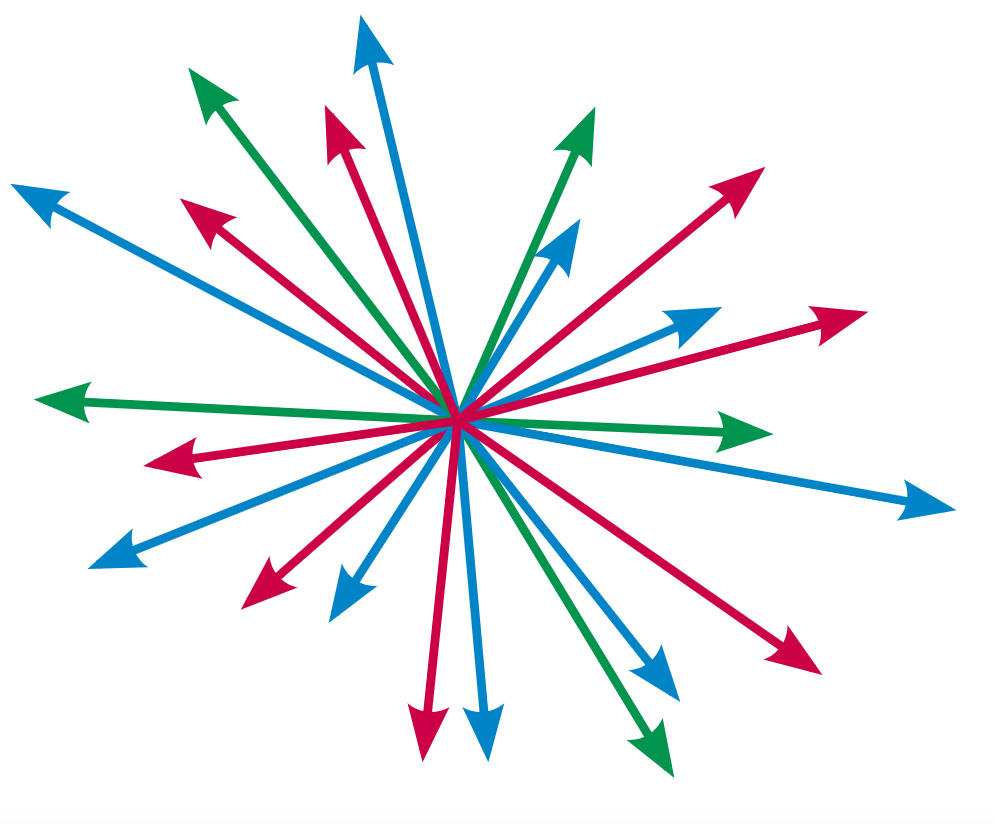
Oleg Alexandrov, vector space illustration. Public domain, via Wikimedia Commons.
Counterpath Press’s series of now thirteen computer-generated books, Using Electricity, offers a refreshing alternative to the fantasia of terror and wonder that we’ve all been subjected to since the public release of ChatGPT. The books in this series present us with wide-ranging explorations into the potential interplay between human language and code. Although code-based work can be dauntingly hermetic to the noncoder, all computationally generated or mediated writing is the result of two fundamental decisions that remain in the hands of the human author: defining the source text(s) (the data) and choosing the processes (the algorithms or procedures) that operate on them. A text generator like ChatGPT uses brute force on both sides—enormous amounts of text vacuumed from the internet are run through energy-intensive pattern-finding algorithms—to create coherent, normative sentences with an equivocal but authoritative tone. The works in Using Electricity harness data and code to push language into more playful and revealing imaginative territory.
Many of Using Electricity’s authors mobilize computational processes to supercharge formal constraints, producing texts that incessantly iterate through variations and permutations. In The Truelist, Nick Montfort, the series editor, runs a short Python script to generate pages of four-line stanzas comprising invented compound words. “Now they saw the lovelight, / the blurbird, / the bluewoman facing the horse, / the fireweed.” The poem is a relentless loop—repeating this same structure as it churns through as many word combinations as it can find. Rafael Pérez y Pérez’s Mexica uses a pared-down, culturally specific vocabulary and a complex algorithm to generate short fairy tale–like stories. One begins, “The princess woke up while the songs of the birds covered the sky.” The skeletal story structure swaps different characters and actions as the variations play out. It’s like watching a multiversal performance of the same puppet show.
I find that often I am not reading these works for meaning as much as for pattern, which is at the heart of how computation operates. Allison Parrish’s fantastic Articulations brings us frighteningly deep into the core of computational pattern searching. Drawing from a corpus of over two million lines of poetry from the Project Gutenberg database, she takes us on a random walk through “vector space.” Put simply, this is the mathematical space in which computers plot similarities between different aspects of language—the sound, the syntax, whatever the programmer chooses. The result is a dizzying megacollage/cluster-mash-up of English poetry in which obsessive and surprising strings constantly emerge—a vast linguistic hall of mirrors. “In little lights, nice little nut. In a little sight. In a little sight, in a little sight, a right little, tight little island. A light. A light. A light. A light. A light.”
Many of these works are indebted to the wider traditions of procedural, concrete, conceptual, and erasure poetry, while making use of code’s unique possibilities for play, chance, variation, and repetition. Stephanie Strickland’s Ringing the Changes draws its mathematical ordering process from a centuries-old practice of English bell ringing. In Experiment 116, Rena Mosteirin plays a game of translation telephone by running Shakespeare’s “Sonnet 116” through multiple languages in Google Translate and back into English.
The three most recent titles, released in April, comprise some of the series’s most varied and dynamic approaches to digital poetics. There is an updated edition of Image Generation by the pioneering literary artist John Cayley; as well as Qianxun Chen and Mariana Roa Oliva’s Seedlings, which uses the metaphor of seeds and trees, and “grows” word structures that evoke the dynamics and fragility of plant life. One of the most exciting titles thus far, especially from the perspective data source, is Arwa Michelle Mboya’s Wash Day, in which she threads together transcripts of YouTube videos of Black hair vloggers sharing their Wash Day rituals. The result is an immersive, polyvocal, multiauthored narrative that reveals the unique capacity of data and computation to give presence to specific communities. Wash Day provides an extraordinary contrast to the normalized, bulk-writing superstores of commercial text generators. That deep attention to language—its potential, its limits, its expressive capabilities, its necessity, and its fragility—is the central quality all these authors share. Hopefully works like theirs can help us imagine much more resonant and compelling digital futures.
Jonathan Thirkield is a poet, coder, and digital artist. He teaches computational media and digital arts at The New School, Parsons, and Columbia University. His second collection of poetry, Infinity Pool, is forthcoming from the University of Chicago Press in fall 2024. His poem “Antwerp (2)” appears in our new Summer issue, no. 244.
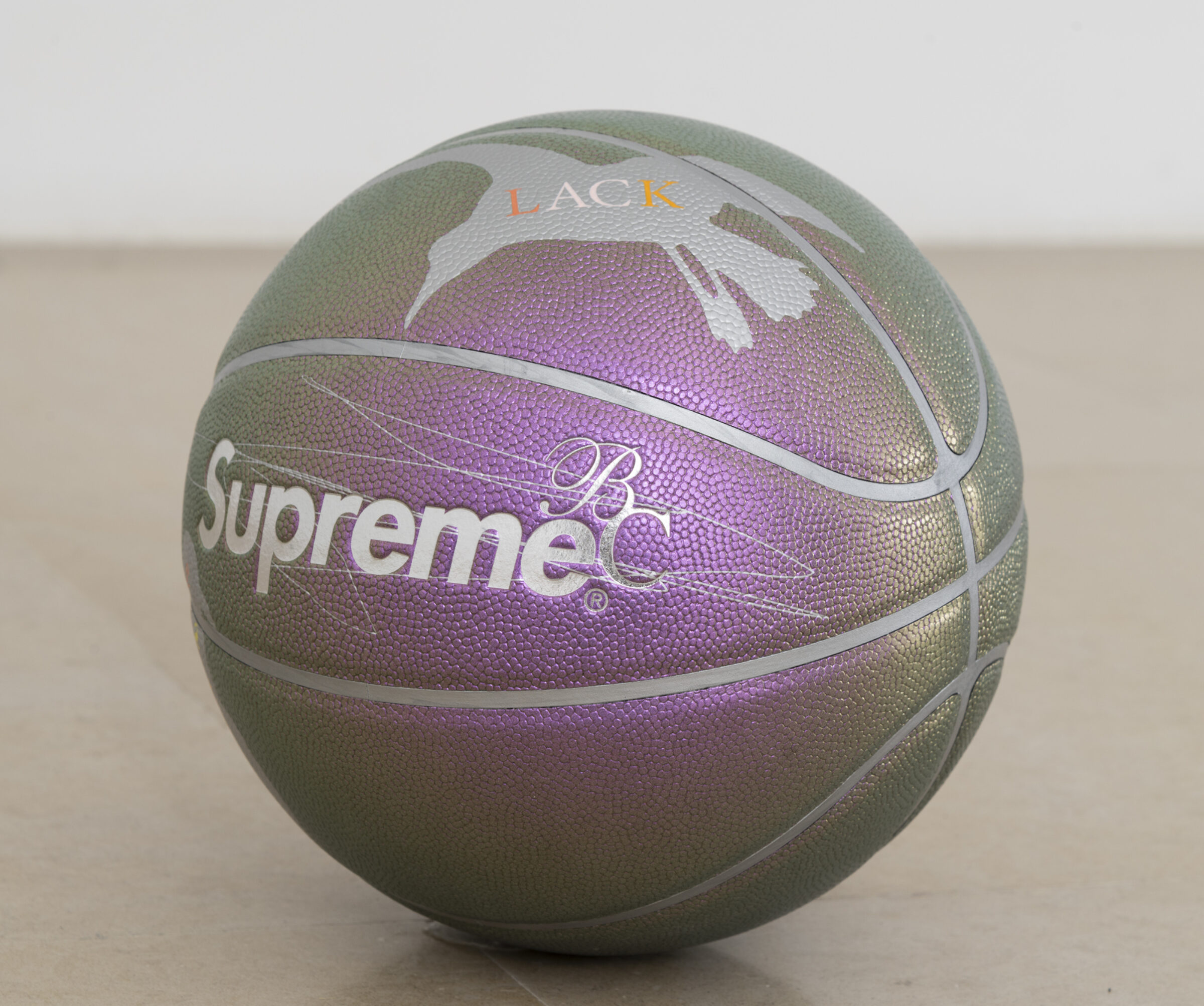
Bernadette Corporation, Untitled, 2023. Courtesy of Greene Naftali.
This week, three reviews on damaged art, art out of time, art of our time, and enjoying the void.
We’re in a particular phase of “pandemic art” now—I don’t mean work that portrays the spread of disease (I’ll leave The Last of Us to another writer) but the work that artists made while they lived in hibernation: writers at their desks with no social obligations to draw them out into the city, artists in their studios with the endless horizon of hours receding. Now they are showing what they made. Tara Donovan’s stunning “screen drawings,” on view last month at Pace Gallery in Chelsea, are a project begun in that period. The “drawings” are made from typical aluminum insect screens, cut and tweezed into intricate geometric patterns—layered lines, swirls, and cutouts—that shimmer and morph as you walk through the gallery. They are subtle optical illusions cut from the humblest everyday material. Their connection to the period of “high quarantine” strikes me immediately: time spent looking out the window onto silent streets, time spent feeling intensely aware of the need for protection. The discourse around “screen time” is of course fatiguing, but Donovan’s drawings for me reinvigorate the multiple meanings of the phrase. Before we came to understand the screen as the portal that brought the outside infinity into our personal space, screens were more often for keeping something out: a fugitive look, a bothersome fly. (I saw Donovan’s work around the same time as I became aware of an interesting but disquieting TikTok trend of overlaying TV clips with ASMR videos, in case you didn’t have enough stimulation.) What else do they continue to separate from us? A special quality of Donovan’s manipulations is that no photo of them can do them justice—they look good in two dimensions, but in person they are almost hypnotic in their immersive power. They’re hardly capturable as digital artifacts, and so much the better.
—David S. Wallace, contributing editor
Going eight floors up the elevator at Greene Naftali on my lunch break and out into the open white space that recently housed the gallery’s Bernadette Corporation exhibition felt a lot like walking into God’s office on his break from Creation: there were whiteboards covered with half-assed frescos and half-erased flowcharts; pennies, some stacked neatly, others laid out in the shape of man; on the white plinths supporting them, more doodles of equations, apples, and names begun and then abandoned. It all connects, of course, somehow—this stuff, these ideas. The scribbles suggest motion and relation, formal analogies (between pie charts and pennies, currency and chemistry), but the forces of association seem to give out halfway. The only thing left whole was an oil-slick-iridescent Supreme-branded basketball, spherical and sparkly, that seemed to have bounced straight out of those equations and onto the floor. God must have gotten bored setting up gravity, orchestrating economies, making paintings, and doing anti-capitalist art critique. But he still likes to play—and shop. The effect, difficult to execute and surprisingly lovely, is of a beautifully bad throw of the ball: an immaculate weak gesture, conceptually and aesthetically. I didn’t mind; such are the times. If I were God I’d take a break, too. Sunlight still flooded the mostly empty room. I wished it had all been even weaker, that there’d been couches and a coffee machine, to make the art recede even further into the scene of the God-office/gallery, and to make it easier for me to sit around and play on my iPhone. The show closed last weekend, but that’s okay. Its brilliance is that it was only half-there to begin with. You can still go answer your emails on the eighth floor of Greene Naftali on your lunch break if you work in Chelsea.
—Olivia Kan-Sperling, assistant editor
Lately, I’ve been rereading Molly Brodak’s 2020 poetry collection The Cipher. I first read it more than a year ago and have found myself returning to it ever since, whenever I’m in need of a line to carry me through the day. This time, I’ve been drawn to moments when opulent, lush textures adjoin absences or voids. There’s the extravagant feast of “The Babies,” for example, rendered in exquisite detail but forbidden to eat. In “Axiom,” a cloth of yellow silk enfolds the empty space where the Ark of the Covenant would be kept, were it ever recovered or had it ever even really existed. The guard at the door watches over an empty chamber containing only the silk, and, at times, a ray of light. Describing the inspiration for her poem “The Flood”—which describes a Paolo Uccello fresco of the Noah’s Ark, which has itself been damaged by a real flood—she writes: “I don’t know if I would like the painting as much if it hadn’t been damaged. It is another painting now.” This reminds me of another one of her lines, from “Conversation”: “I imagined / a bolt of pink waterstained silk / in place of me, being / loved.” It is a marked object—textured with the evidence of utility, accident, or event—with which Brodak chooses to represent herself. In her work, things that change are never ruined; they are merely renewed as variations on themselves.
—Leena Mahan, reader
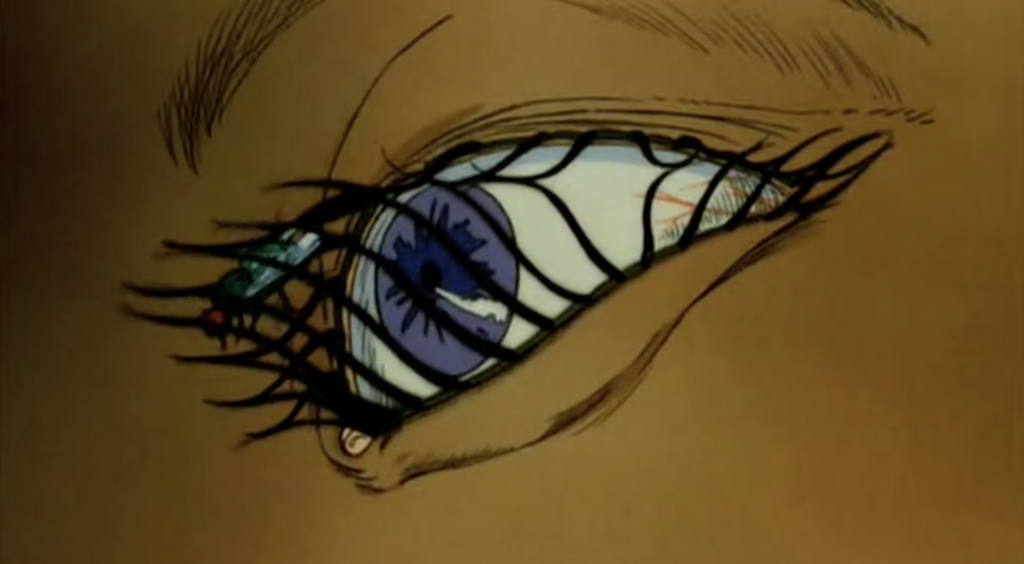
Detail from the title sequence of Peter Chung’s Æon Flux.
What is this video? A plot summary might run something like this: A low-quality cell phone records, in slow motion, a small suburban lake being stocked with fish. A long, transparent inflatable tube runs the fish from a truck across a lawn and into the lake. They get stuck; they struggle; they clog the tube; they swim, weakly, upstream; and eventually men in aprons (the fish stockers?) pick up the tube and force the last fish out. Neighbors (I presume) have gathered to watch the process—children are filming, a lone man reaches out piteously to stroke the clots of confused fish through the tube, and a goldendoodle’s fluffy head bobs in and out of the frame. The video, by the artist Barrett White, borrows its grand title—“Pessimism of the Intellect, Optimism of the Will”—from Gramsci’s Prison Notebooks and letters, in which that phrase describes the coexistence of apparently contradictory orientations to the world. White sets the video’s banal footage to Arvo Pärt’s solemn “Cantus in memoriam Benjamin Britten,” complete with periodically tolling bell.
The video’s appeal is its constant oscillation between tragedy and, well, bathos. At first, the video seems like a funny TikTok—grand music, slo-mo, grainy vertical footage, silly suburban fish situation. Ha. But then it goes on for almost eight minutes? Just as Dolly Parton’s “Jolene” becomes a gorgeous and resigned dirge when slowed down (recommend), something about the dilation of time changes the tonality of White’s video. It creates space for an aesthetically sensible movement between the video’s contradictory tonal cues. This extension of time allows for multiple and layered juxtapositions of grand and banal. You can really feel this circulation when you’re watching it—feel the way your own feeling turns into its apparent opposite, and back.
I’ve returned to this video repeatedly since I first saw it last year. It has a total of 110 views as of February 1, at least ten of which are mine. Sometimes I notice the way the tumble of the fish’s bodies looks like a Renaissance etching of sinners tumbling into hell; sometimes I notice the bearded man’s camo pants; sometimes I notice the confused pathos of the man who leans out to touch the knot of disoriented trout—and I feel, like him, the terror of the fish, and sadness for them. Like the fish, I feel the force of the cues at play—for them, it’s water pushing one way; for me, it’s the music’s command to FEEL! PATHOS NOW!, which also has the ironic overlay of saying how silly it is, to feel that. But I resist: I don’t like being told what to feel, and if I do feel something like mourning, maybe I’m a fool. Maybe those feelings are out of scale, out of tune with the world as it actually is. Or maybe when I see this situation as ridiculous, and I’ve accepted a certain kind of banality, that’s when I’m out of tune with the world as it actually is. Maybe this tube leads to death. Or maybe it leads to another slightly larger holding tank that is just fine.
—Kirsten (Kai) Ihns, reader
Barn sour, an equestrian term, describes a domesticated horse who doesn’t want to leave its home. A barn sour horse will resist being taken from its stable, often violently. If they are forced out, they might bolt back home, throwing their rider off their back, sometimes trampling them. The term has been taken as the name for a mysterious sound-collage artist from Winnipeg, Canada. I came across Barn Sour’s tape horses fucked over the head with bricks in late 2019, on which sparse harmonies on a detuned piano are dubbed over recordings of manic laughter and guttural glossolalia. It is just under nine minutes long, incredibly disturbing, and absolutely mesmerizing. It was released under two pseudonyms, one of which is C. Lara, the name of a real racehorse. The other is James Druck, a long-dead fraudster implicated in a scheme to kill show horses in order to collect insurance money. (James Druck’s daughter, whose childhood horse was among the horses killed, is also the inspiration for a central character in Jay McInerney’s novel Story of My Life.)
I feel like I’m watching scenes from a horror movie on a deteriorating VHS tape in a large, cold, empty house: the gruesome images are hard to make out; I can’t tell if the fuzziness is making the experience more or less fascinating or nauseating. Most of Barn Sour’s releases have titles invoking an esoteric reference to equine terminology. Soap & Glue, their compendium album, released by Penultimate Press this year, takes its name from two products historically made from ground-up horse parts. It’s a suitable name for the album, which is full of reworkings and rebludgeonings of their previously released material—but also because it is billed as Barn Sour’s final release, their death, their body of work ground to a pulp. Join them for a final foal-y à deux before they trot back to their barn for good.
—Troy Schipdam, reader
While visiting my hometown this winter, mildly jet-lagged, I started waking up at 4 A.M. To kill time before the sun rose, I’d watch an animated sci-fi show from the early nineties. Æon Flux (1991-1995)—which first aired as a series of six experimental films on MTV’s late-night showcase for indie animators—is perfectly suited for the borderland between dreaming and consciousness. In the iconic title sequence, an insect lands on a woman’s cheek and crawls into her open, pupilless eye only to be captured in its lashes, as in a Venus flytrap, when the lids snap shut. The eye reopens and the pupil swivels into place, bringing its prey into focus. Many of the elements that earned the show its cult following are there in the intro: hallucinatory images, biopunk body augmentation, a bit of eroticized violence. Set in an ultramodern dystopia, Æon Flux follows the titular character, a femme fatale–type (slicked-down black hair, violet irises, bondage gear) who works as an assassin for the resistance. We quickly learn that Æon is a morally ambiguous antiheroine traveling between two competing societies: the anarchic Monica and the technocratic police state Bregna, ruled by an Aryan-blond despot (and Æon’s nemesis-lover) called Trevor Goodchild. Æon is frequently killed and reincarnated before the credits roll.
Æon Flux is a masterpiece of visual storytelling. Its early episodes are free of dialogue and instead rely heavily on clusters of impressions and shifts in perspective. Influenced by Egon Schiele, the French cartoonist Moebius, and manga artists like Kazuo Umezu and Osamu Tezuka, the creator and director Peter Chung’s style is defined by expressive lines. He prioritizes evocative character design—elongated, sinewy figures, angular architecture—over surface detail. The series is a combination of fetish content, classic sci-fi, and, according to some fan theories, Gnostic symbolism. In one episode, the body of a soldier is reanimated so his belly can be used to gestate a godlike being with an iridescent halo. In another, a woman’s shattered vertebra is surgically removed, allowing her to rotate her body a full 360 degrees, and replaced with a device that reseals her spinal column with the push of a button. Late in the series, Æon clones her own body in a biotech laboratory, and, in a campy allusion to Narcissus and his reflection, she kisses her surrogate self as she emerges from a pool of water.
Consuming a nonstop stream of images like this for a few hours each morning, under my parents’ roof once more, left me feeling delirious and impossibly old. But Chung’s characters, with their contortionist acrobatics and cyberpunk experiments, also plucked the string inside me that tethers me to my kid self, the one who read books about dystopian futures, kissed girls in their bedroom once their parents had gone to sleep, and tried to decide what they wanted to do with their body.
—Jay Graham, reader
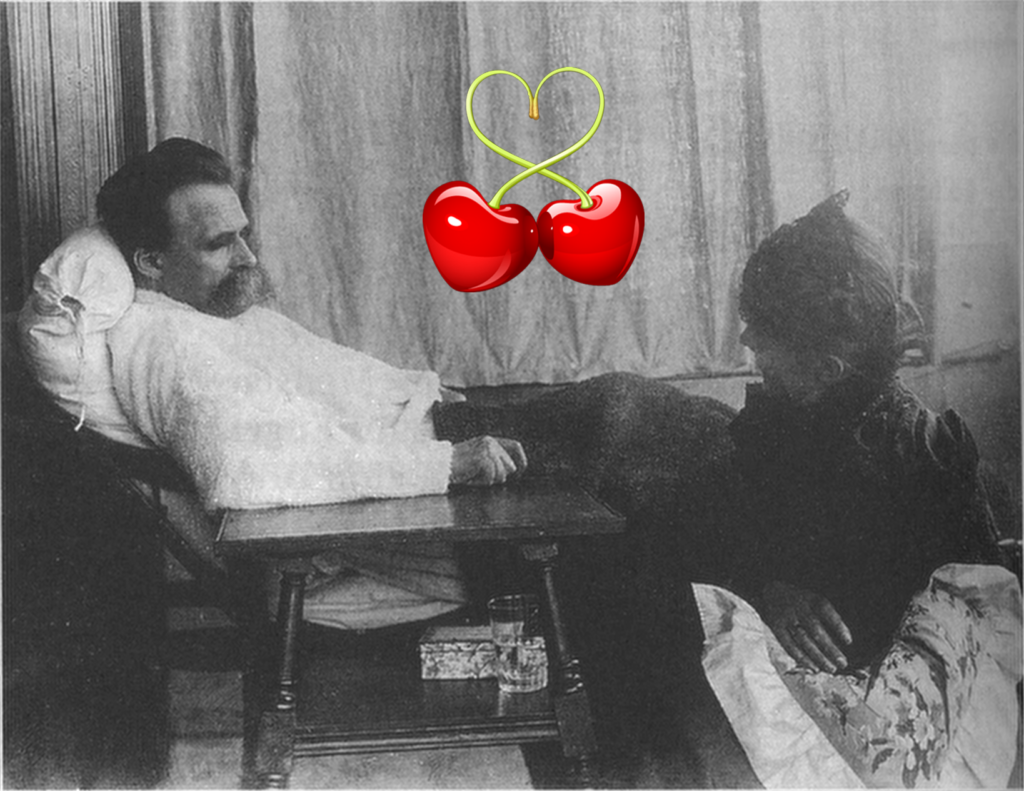
Hans Olde, from “Der kranke Nietzsche” (“The ill Nietzsche”), June–August 1899. Goethe- und Schiller-Archiv Weimar.
After two vodka tonics and a cosmo, my ninety-year-old grandmother lifts her glass and says, “But you know that Nietzsche is my boyfriend?”
“He is?”
“He’s my boyfriend.”
It’s all right—we’ve shared boyfriends before. The actor Javier Bardem. Errol Louis, anchor at NY1. Her new neighbor. Her many doctors. She tells me that Nietzsche is her boyfriend because Nietzsche also hates the German composer Richard Wagner. I tell her Nietzsche hates a lot of people. She nods. “That’s good in a man.”
Earlier in our dinner I’d mentioned I was finally reading Nietzsche’s Twilight of the Idols and The Antichrist—two white-hot texts that serve, in part, as the ecstatic summation of much of Nietzsche’s previous work. Both works glow with special invective. The usual targets are abused (Socrates, Kant, et cetera). So are George Sand, George Eliot, and, of course, generally happy people: “Nothing could make us less envious than … the plump happiness of a clean conscience.” It’s in Twilight that Nietzsche announces, “The man who has renounced war has renounced a grand life.”
Would he be a good boyfriend? He’d be a fierce one, often railing at the “radical and mortal hostility to sensuality.” He’d remind you: “When a man is in love he endures more than at any other time; he submits to anything.” Would he wink? Probably not.
Freud claimed, apparently, that Nietzsche “had a more penetrating knowledge of himself than any man who ever lived or was likely to live.” In these final writings it is clearer than ever how Nietzsche’s “hate” evolves out of a prolonged annoyance at knowing people—and history and philosophical systems—better than they know themselves. You sense the loneliness of this awareness. Nietzsche needs his supernatural, self-generating heat, lest his flame down there wither in the wild pits of instinct. (“Nothing ever succeeds which exuberant spirits have not helped to produce.”) If he was your lover, he’d remind you, his torch high, that “one must be superior to mankind in force, in loftiness of soul—in contempt.” Those who cannot achieve this are “merely mankind.”
I look at my grandmother, whose awareness—as Nietzsche might recommend—seems to recede from the outside world as it advances internally. She closes her eyes. I think she’s slipped under when she points at me. “First it’s our Spanish fellow. Then that other fellow. Then Nietzsche.”
—Sophie Madeline Dess, author of “Zalmanovs”
A friend whose taste I trust recently recommended Denton Welch’s 1945 novel In Youth Is Pleasure, a beautiful little book and one of my favorite discoveries of 2022. Welch’s writing is impressionistic, playful, homoerotic, dreamy, often hilarious, and at times ecstatic. What plot there is centers on the fifteen-year-old Orvil Pym, who is spending the summer holiday with his father and brothers at a hotel in Surrey several years before the outbreak of World War II. Orvil’s mother has died; his feelings for his siblings and for his father (who has bestowed upon him the nickname “Microbe”) range from vague fondness to childish terror and loathing. Often Orvil is left alone. He eats pêche Melba (“‘It’s like a celluloid cupid doll’s behind,’ said Orvil to himself. ‘This cupid doll has burst open and is pouring out lovely snow and great big clots of blood’”); he spies jealously on a schoolmaster reading Jane Eyre to two boys, one of whom appears to be taking a particular kind of gratification from the experience; he desecrates a church with libidinal glee, throwing himself on a brass statue and kissing its face “juicily.” At the end of the day, Orvil always seems to be consuming oozing cakes in the hotel dining room, dressed in mud-stained clothes.
This is a lonely book, and a remarkable one for the way in which its sensuality emerges: from inside this loneliness. Orvil takes an aesthete’s pleasure in the physical world but also in the eruptions of his own consciousness; much of the novel’s eroticism arises from his encounters with a kind of other within the self. Desire, enchantment, the delights of reverie and of metaphor—these spring from within. Floating alone along a river, Orvil thinks, “I’m like one of those Baked Alaskas … one of those lovely puddings of ice-cream and hot sponge.” Here, loneliness can be devastating, mischievous, grotesque, monstrous, thrilling—but it is never grim.
—Avigayl Sharp, author of “Uncontrollable, Irrelevant”

Still from Anya Zalevskaya’s Posle priliva (2020). Courtesy of the director.
In the fall of 2019 I was newly living in the Midwest. In my free time, I’d take long, aimless walks, trying to tune to the flat cold of the place. On one such walk I got a call from my friend Anya Zalevskaya; she was in Odesa, she said, working on a film, a documentary about the Ukrainian (but also Romanian, Jewish, and Soviet) director Kira Muratova. When Anya called, it was almost midnight in Odesa. She was sitting on a bench by the Black Sea; I could hear the waves, the inhale of her cigarette. What film of Muratova’s should I watch first? I asked her. Ah, she said, The Asthenic Syndrome, for sure.
1990’s The Asthenic Syndrome takes us to Odesa, too, but this is an Odesa at the fraying edge of a Soviet time-space where, significantly, we never see the sea. The film is shot in places that suggest a borderland, an edge, a wobble: construction sites, mirrors, photographs, headstones, film screenings, cemeteries, a dog pound, a hospital ward, a soft-porn shoot. This in-between sense is temporal, as well: Muratova notes that she “had the great fortune of working in a period between the dominance of ideology and the dominance of the market, a period of suspension, a temporary paradise.” As with the asthenic syndrome itself (a state between sleeping and waking), the film is a realization of inbetweenness, an assembly of frictions and crossover states we feel through form: through Muratova’s use of juxtaposition; through her uncanny overpatterning of echoes and coincidences; through the shifts of register between documentary and opera. The film doesn’t proceed so much as weave itself in front of us, in a dazzling ivy pattern of zones and occurrences. You could call it late-Soviet baroque realism.
The film is really two films. The first, in black and white, opens out into a funeral. It’s for the husband of Natasha, we learn—a middle-aged woman possessed, in the ensuing scenes, to the very end of herself with grief. Because grief invents the road it travels, Natasha—like her audience—does not herself know what she will do next. With terrifying speed, she quits her job as a doctor, insulting coworkers in the process; takes a drunk home, tells him to strip, beds him; shoves and insults passersby. All this is captured in the camera’s eye, however, with a disinterested dignity. And then, abrupt as Natasha’s shoving, the first film breaks into the second (I’ll leave you to see the how and the why—it’s great).
At the epicenter of the second film is the exhausted Nikolai, a schoolteacher who nods off in moments of emotional intensity. Occurrences flare up around Nikolai like religious antimiracles—a carp torn apart by female fingers as “Chiquita” plays, a high school boy imitating a game show host, the agonizing panorama of the dog pound. This is the social and inner world in abjection, yes: but because abjection is possible, the film seems to say, so is human dignity. The question of dignity binds the viewer to the film’s concern: what is the human when it is shorn of category, of psychology, of system? What are we when we are together? What are we when we are alone?
In the rare interviews she gave, Muratova often mentioned her philosophy of film: what she called dekorativnost’ (ornamentedness) and sherokhovatost’ (roughness). (Thanks to Mikhail Iampolski’s 2021 talk “A World without Reality” for many of the Muratova quotes here.) The viewer, Muratova thought, should encounter the film’s reality as an ornament, a woven carpet, a fabric: completely antisymbolic, and thus anti-ideological; completely antipsychological, and thus antistereotypical. Reality itself, she argued, can only be looked at, admired—not interpreted, understood, or possessed. Reality doesn’t “mean,” it is. As when, in an interview, Muratova is asked: “What do the horses in your films symbolize?” To which she replies: “What do the people symbolize?”
There’s no neat ending possible here in good faith; rhetoric and delicacy are insults to the present situation, and if the Black Sea that I heard over the phone in 2019—unsymbolic itself—still crashes and breaks as it always has, it sounds differently now in the human ear. Anya’s remarkable short film, Posle priliva (After the Tide, available with English subtitles here) is a pursuit of reality in Muratova’s footsteps that trusts in the uses of intuition, coincidence, error, and attention. Like Muratova, Anya immerses herself in the reality the film pursues—in this case, Odesa in 2019—and in the people, encounters, scenes, and things that this reality happens to make available in a given moment. She gives herself over to what will disclose itself; she’s not so much seeking something as she is listening, with intuition’s ear, for the inevitable that is the soul of chance. Neither of their films are ever “random,” and therein lies their art. Posle priliva came out in 2020. In 2023, it has become an elegy to a time and place, a specter and a document of what was. Not unlike The Asthenic Syndrome, which has come to mark a period (late perestroika, pre-collapse) that now haunts in its total irrecoverability.
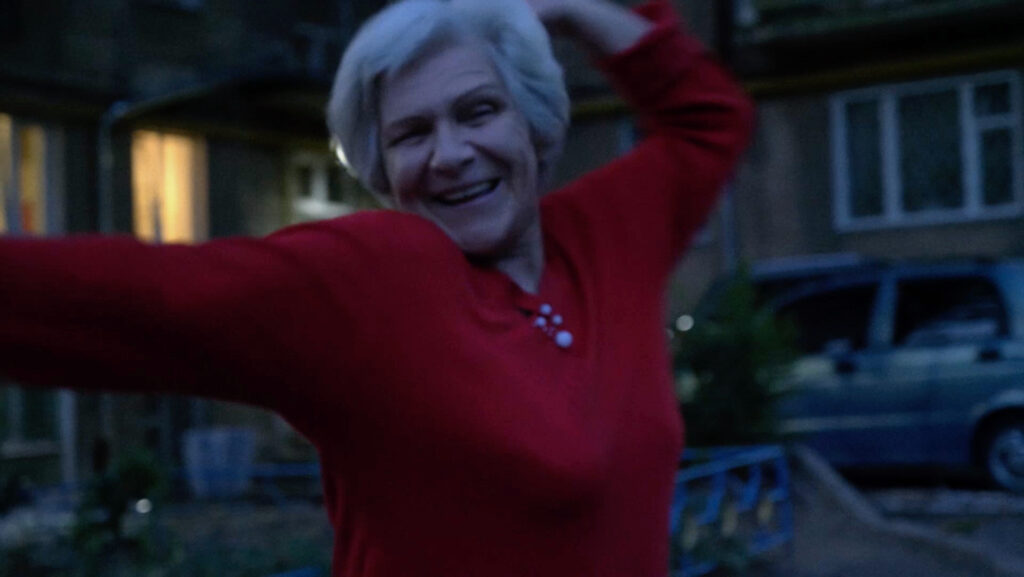
Still from Anya Zalevskaya’s Posle priliva (2020). Courtesy of the director.
Timmy Straw is a poet, musician, and translator. Their poems “Brezhnev” and “Oracle at Dog” appear in our new Winter issue, no. 242.